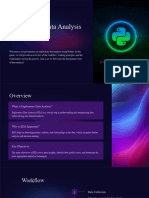0% found this document useful (0 votes)
17 views2 pagesAssignment 1
The document outlines a series of questions related to Exploratory Data Analysis (EDA), covering basic concepts, descriptive statistics, data cleaning, visualization, real-world applications, and advanced thinking. It addresses the importance of EDA, the differences between EDA and data cleaning, and the steps involved in EDA, as well as techniques for handling data and visualizing relationships. Additionally, it emphasizes the role of EDA in making data-driven decisions and highlights potential pitfalls and tools for effective analysis.
Uploaded by
jyotii.pandey7730Copyright
© © All Rights Reserved
We take content rights seriously. If you suspect this is your content, claim it here.
Available Formats
Download as DOCX, PDF, TXT or read online on Scribd
0% found this document useful (0 votes)
17 views2 pagesAssignment 1
The document outlines a series of questions related to Exploratory Data Analysis (EDA), covering basic concepts, descriptive statistics, data cleaning, visualization, real-world applications, and advanced thinking. It addresses the importance of EDA, the differences between EDA and data cleaning, and the steps involved in EDA, as well as techniques for handling data and visualizing relationships. Additionally, it emphasizes the role of EDA in making data-driven decisions and highlights potential pitfalls and tools for effective analysis.
Uploaded by
jyotii.pandey7730Copyright
© © All Rights Reserved
We take content rights seriously. If you suspect this is your content, claim it here.
Available Formats
Download as DOCX, PDF, TXT or read online on Scribd
/ 2

























































